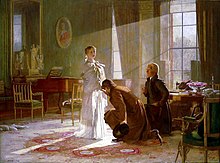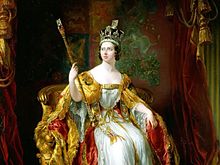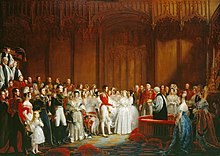Early reign

Victoria receives the news of her accession from Lord Conyngham (left) and the Archbishop of Canterbury.
Since 1714, Britain had shared a monarch with Hanover in Germany, but under Salic law women were excluded from the Hanoverian succession. While Victoria inherited all the British dominions, Hanover passed instead to her father's younger brother, her unpopular uncle the Duke of Cumberland and Teviotdale, who became King Ernest Augustus I of Hanover. He was her heir presumptive until she married and had a child.[35]

Coronation Portrait of Queen Victoria by George Hayter
At the start of her reign Victoria was popular,[40] but her reputation suffered in an 1839 court intrigue when one of her mother's ladies-in-waiting, Lady Flora Hastings, developed an abdominal growth that was widely rumoured to be an out-of-wedlock pregnancy by Sir John Conroy.[41] Victoria believed the rumours.[42] She hated Conroy, and despised "that odious Lady Flora",[43] because she had conspired with Conroy and the Duchess of Kent in the Kensington System.[44] At first, Lady Flora refused to submit to a naked medical examination, until in mid-February she eventually agreed, and was found to be a virgin.[45] Conroy, the Hastings family and the opposition Tories organised a press campaign implicating the Queen in the spreading of false rumours about Lady Flora.[46] When Lady Flora died in July, the post-mortem revealed a large tumour on her liver that had distended her abdomen.[47] At public appearances, Victoria was hissed and jeered as "Mrs. Melbourne".[48]
In 1839, Melbourne resigned after Radicals and Tories (both of whom Victoria detested) voted against a Bill to suspend the constitution of Jamaica. The Bill removed political power from plantation owners who were resisting measures associated with the abolition of slavery.[49] The Queen commissioned a Tory, Sir Robert Peel, to form a new ministry. At the time, it was customary for the prime minister to appoint members of the Royal Household, who were usually his political allies and their spouses. Many of the Queen's Ladies of the Bedchamber were wives of Whigs, and Peel expected to replace them with wives of Tories. In what became known as the bedchamber crisis, Victoria, advised by Melbourne, objected to their removal. Peel refused to govern under the restrictions imposed by the Queen, and consequently resigned his commission, allowing Melbourne to return to office.[50]
Marriage
Though queen, as an unmarried young woman Victoria was required by social convention to live with her mother, despite their differences over the Kensington System and her mother's continued reliance on Conroy.[51] Her mother was consigned to a remote apartment in Buckingham Palace, and Victoria often refused to meet her.[52] When Victoria complained to Melbourne that her mother's close proximity promised "torment for many years", Melbourne sympathised but said it could be avoided by marriage, which Victoria called a "schocking [sic] alternative".[53] She showed interest in Albert's education for the future role he would have to play as her husband, but she resisted attempts to rush her into wedlock.[54]Victoria continued to praise Albert following his second visit in October 1839. Albert and Victoria felt mutual affection and the Queen proposed to him on 15 October 1839, just five days after he had arrived at Windsor.[55] They were married on 10 February 1840, in the Chapel Royal of St. James's Palace, London. Victoria was besotted. She spent the evening after their wedding lying down with a headache, but wrote ecstatically in her diary:
Albert became an important political adviser as well as the Queen's companion, replacing Lord Melbourne as the dominant, influential figure in the first half of her life.[57] Victoria's mother was evicted from the palace, to Ingestre House in Belgrave Square. After the death of Princess Augusta in 1840, Victoria's mother was given both Clarence and Frogmore Houses.[58] Through Albert's mediation, relations between mother and daughter slowly improved.[59]I NEVER, NEVER spent such an evening !! ! MY DEAREST DEAREST DEAR Albert ... his excessive love & affection gave me feelings of heavenly love & happiness I never could have hoped to have felt before! He clasped me in his arms, & we kissed each other again & again! His beauty, his sweetness & gentleness – really how can I ever be thankful enough to have such a Husband! ... to be called by names of tenderness, I have never yet heard used to me before – was bliss beyond belief! Oh! This was the happiest day of my life![56]

Contemporary lithograph of Edward Oxford attempting to assassinate Victoria, 1840
Victoria's household was largely run by her childhood governess, Baroness Louise Lehzen from Hanover. Lehzen had been a formative influence on Victoria,[65] and had supported her against the Kensington System.[66] Albert, however, thought Lehzen was incompetent, and that her mismanagement threatened the health of his daughter. After a furious row between Victoria and Albert over the issue, Lehzen was pensioned off, and Victoria's close relationship with her ended.[67]



No comments:
Post a Comment